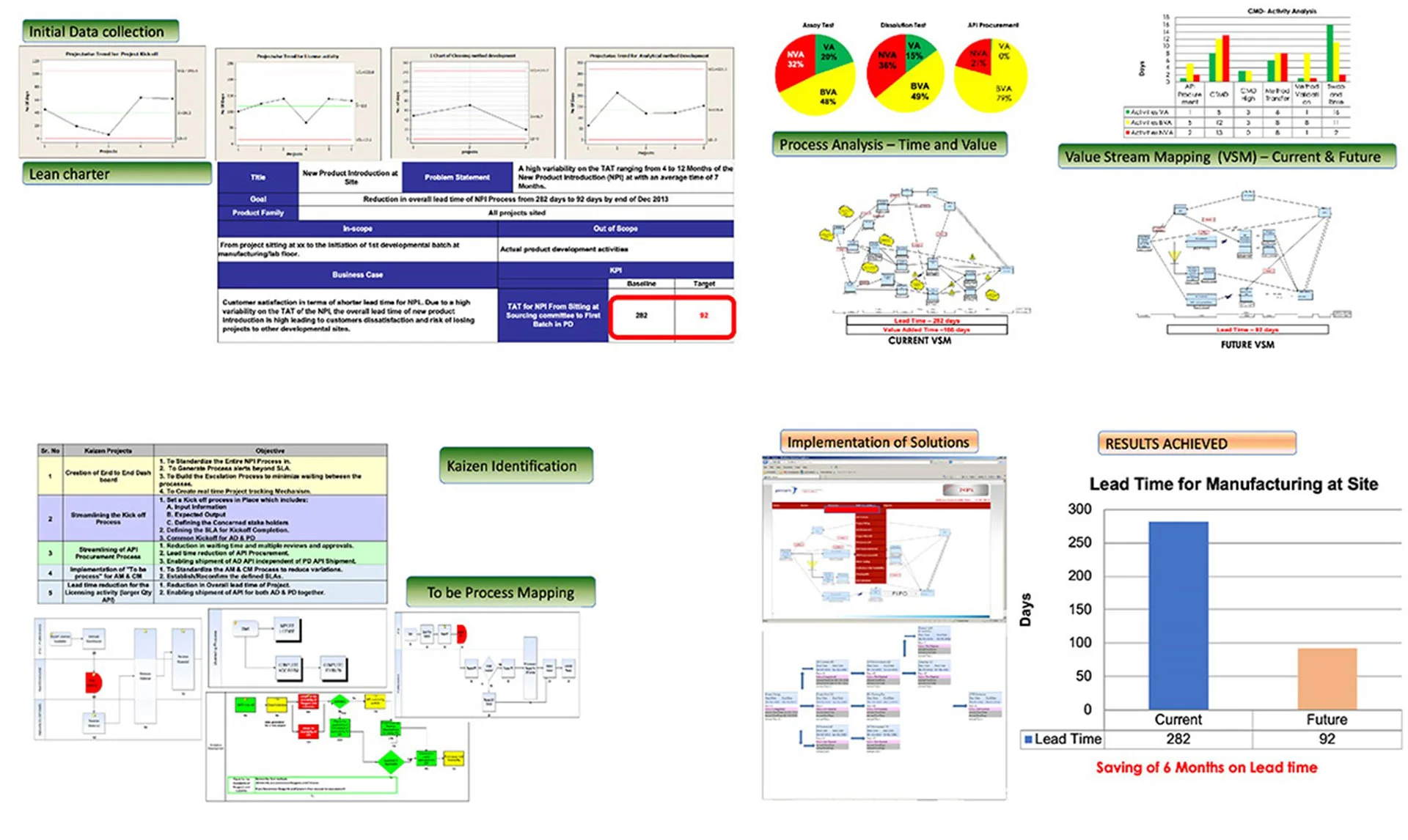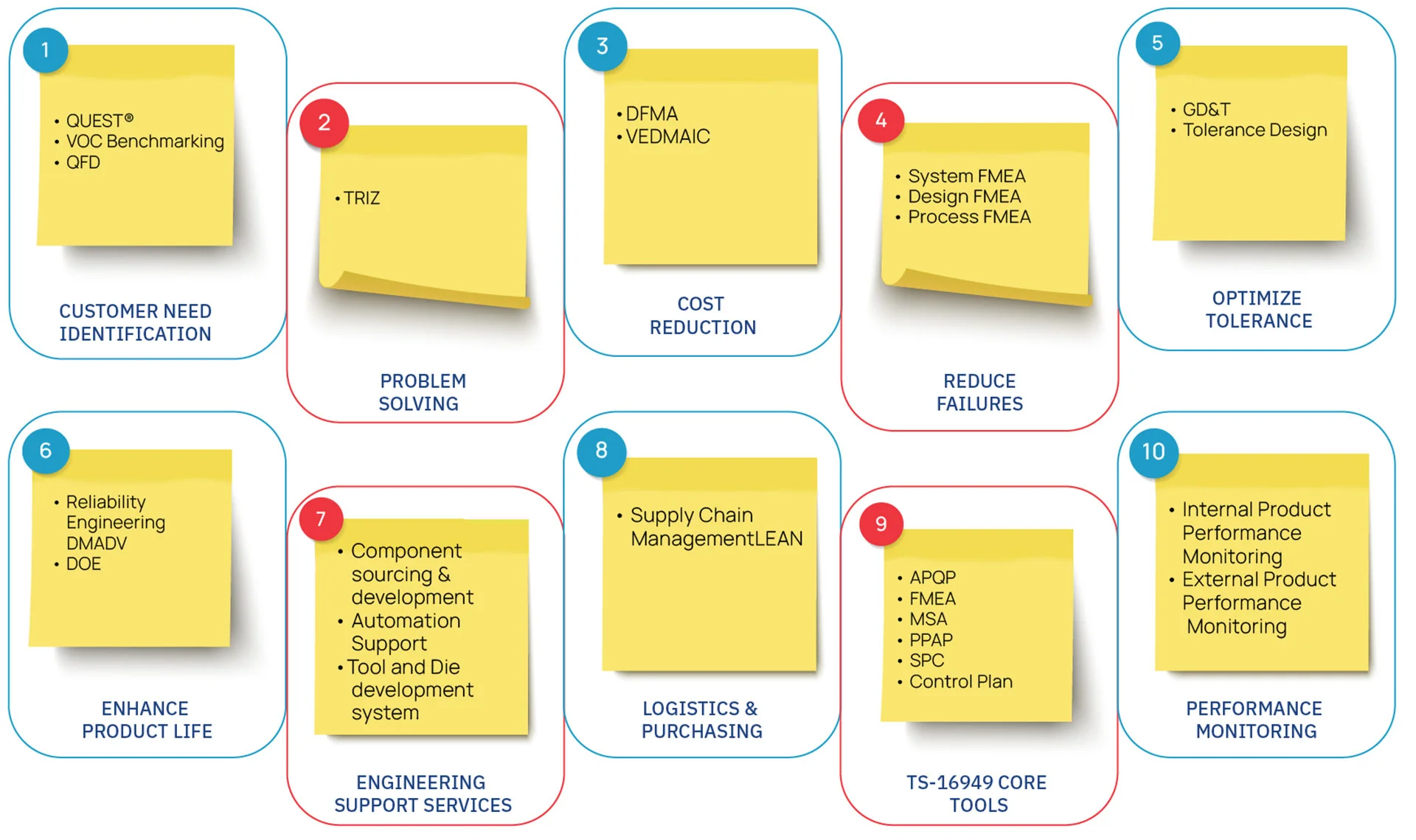Capabilities
Design
Excellence
The Design for Six Sigma (DFSS) is adopted by organizations that want to achieve excellence in designing and engineering First Time Right Products to market. Understanding this requirement, we, at SSA Techknowlogies, have come up with the best DFSS Training & Consulting Services. Our courses are customized for Manufacturing and Service industries as per the requirement. DFSS helps in product redesigning and development by reducing downstream errors and saving money.
The Design for Six Sigma is ideal for Process Engineers, Design Engineers, Tool Designers, Industrial Designers, Product Designers, Quality Engineers, Chief Designers, etc. They benefit from an improved design approach to reduce overall product development errors and costs.
What We Do
It is believed that although achieving a Six Sigma level of quality - 3.4 defects per million opportunity - is feasible in theory, in practice the quality of many products could not be improved beyond 4.5 sigma (1350 DPMO). This is due to the fact that there are a significant number of manufacturing process variations or the result of errors in the product and process design that could not be corrected on the shop floor. Achieving a Six Sigma level of quality is feasible only when the product design/development process takes care of eliminating design errors at a very early stage in product development. In essence, excellence in manufacturing alone cannot help achieve zero defects; excellence in design is also required to achieve this target.
The traditional product development process has limited capability to achieve first-time-right new products. In order to challenge the traditional product development process, and to achieve zero defects in design, a science called ‘Design for Six Sigma’ was developed by the automobile and aircraft manufacturing industries and has become a perfect science today with a well-structured product development process called IDOV (Identify-Design-Optimize-Verify). SSA implements the DFSS with the help of the following tools:

How We Help Clients
- Implement DFSS methodology for developing new products with the shortest lead time, zero defects and low costs.
- Use the IDOV Approach (Identify-Design-Optimize-Verify) approach for designing first-time-right products.
Lean in New Product Introduction
While the DFSS approach focuses on tools, techniques and methodology for a first-time-right design, the application of Lean methodology to the complete design and development processes helps in making the Design Team & processes more agile and use the right frameworks as per product requirements. The application of lean tools helps to focus the teams on the speed of development and aligns the processes and teams differently to make them nimble and improve the delivery of new products.
SSA Techknowlogies has evolved its consulting processes over years of experience across various sectors & domains and recognized that the application of lean in product development is one of the “Strategic Shifts” an organization can make to ensure product leadership. Being first in the marketplace is one of the most important criteria for achieving Product Leadership.
Lean in New Product Development Approach
- Study to formulate a strategy for NPILean
- Top Management enrolment workshop
- Champion Training for the Functional Heads (As required)
- Formation of a team for internalizing the Lean process
- Lean Foundation Training to the team covering the RMAOR© methodology
- NPI “AS-IS” VSM workshop
- Lean Tools and Techniques Training (As required)
- Data collection & establishing the Lean objectives
- Creation of Future State Lean Value Stream
- Design of NPI Lean Systems, Structure & Manual
- Design and document NPI Lean Processes (BPMN Flow diagrams)
- Selection and implementation of suitable PLM processes and stage gate (Product Lifecycle Management) software
- Implementation of Project Management services and handholding with the teams
- Establish Measure Of Performance & Key Performance Indicators including tracking and monitoring systems.
How We Help Clients
We follow our proprietary RMAOR® (Recognise – Map/Measure - Analyze – Optimize – Repeatable) approach to BPMS consulting. In a nutshell, the recognition phase involves value stream mapping, identifying pain areas, creating a process mission, and setting an objective for the exercise. The Map/Measure phase involves data gathering, activity level mapping, departmental input/output analysis, and documentation of customer processes and requirements. The analysis phase involves process time and value analysis, waste analysis, customer and user pain point identification, root-cause analysis, and countermeasure planning. The optimization phase involves solution definition, quick hit implementation, IT system requirement definition, user requirement specification, URS documentation, and solution roll-out planning. Lastly, the repeatable phase involves sustenance planning, IT change management, KPI dashboard creation, daily work management, benefits analysis, and identifying improvement opportunities.

Lean Factory Design
SSA is often approached by clients that are in the process of either expanding their manufacturing facility or setting up a new factory aimed at capacity expansion or product portfolio expansion. While setting up the new facility, it is prudent to avoid old problems and embrace Lean Manufacturing practices to ensure that the new facility follows proven best practices right from the get-go.
What We Do
Our approach to Lean Factory Design (LFD) ensures that the plant functions in a Lean way right from day one. This includes capacity planning, machinery and manpower planning based on current and future demand projections. The objective is to establish a smooth flow and streamlined operations, with the ultimate goal of minimizing or eliminating any form of waste. We also focus on creating a bright, productive and scalable factory by applying “lean thinking” in every aspect of its design. Last but not least, creating streamlined support functions by simplifying the order fulfillment process to ensure timely and hassle-free order execution. Our LFD approach transcends Technology Plan, Factory Automation, Material Handling Plan, Quality Plan, Supply Chain Plan and Warehouse Automation.
How We Help Clients
SSA’s Lean Factory design involves the following stages:

While visualizing the new factory, we take into account
- Short lead time manufacturing.
- Minimum inventory at all stages.
- Ergonomic workstations with easy access to materials and tools.
- 5S & housekeeping.
- Lean order fulfillment process taking into account promised day delivery performance and OTDIF goals.
- Establishing Kanban linkages within the factory and will supply partners.
- Level scheduling practices to deal with demand fluctuations.
- Lean organization structure with value stream thinking to enable just-in-time supplies.
- Inventory planning based on scientific demand analysis.
The objective of product optimization is to reduce total product cost without affecting its functionality, sometimes improving certain features and functions. SSA has implemented cost-reduction strategies in a variety of industries and helped them reduce total production costs and improve profitability.
Product Cost Reduction Approach
Cost and Quality are two key factors that determines where do you stand in competitive market. Product cost reduction uses set of techniques and tools in order to identify potential problems and preventive measures prior to manufacturing, to ensure that desired goals are met.
Product Cost Optimization Methods
SSA works with organizations during their New Product Development (NPD) lifecycle in either of the below scenarios to enable product cost reduction:
- Introduction of new products;
Development of a new product begins with a new idea or understanding unmet market requirements. At SSA Techknowlogies, we use methodologies & tools of Design for Six Sigma (DFSS) in order to achieve optimal cost. DFSS with IDOV (Identify, Design, Optimize and Verify) approach focuses on innovation for new improved functions / component designs, optimal design in product tolerance & process variation, and leads to improved profitability. - Improvement of existing products using Value Engineering;
Improvement in design of existing products starts with getting customer feedback (VOC) data and analyzing & identifying factors to improve. Value Engineering or value analysis (VE/VA) are the techniques used to improve functionality and reduce cost by eliminating unnecessary functions of a product. At SSA Techknowlogies, we apply DMADV (Define, Measure, Analyze, Design and Verify) approach of DFSS along with the VA/VE (Value Engineering) principles. Reliability engineering focuses on increasing product life and reduces warranty claims thus saves cost of repair and maintenance.
Objectives of Product Cost Reduction
- Improved design efficiency.
- Reduce number of parts and eliminate unnecessary ones to reduce raw material cost and reduce maintenance.
- High quality product at lower cost delivering higher value.
- Process optimization and simpler assembly to reduce total lead time.
- Introducing standard products to reduce variations and increase interchangeability.
How We Help Clients
We partner with our clients right at the early stage ofproduct development cycle.The objective is two pronged -- enable the client derivebenefits from the early stages of product development cycle and build a culture of design excellence through skill building and knowledge transfer to the designer community.
Designer Competency Development
In the modern era, the Product Development Cycle is shrinking, demanding a faster New Product Development cycle. The need for developing new products with zero defects at the time of launch is increasing due to competition.
Our Approach
These developments have increased the competency requirements of designers who generally focus on technical/functional competency & are not exposed to a world-class product introduction process applying many quality planning tools. In addition to time & quality in design, most designers are not accountable for the cost of the product since the cost is estimated after the design is completed and it often happens that the market does not find value for money for new products.
In order to address the above issues, the recommended product introduction process has built quality tools, which the designer can apply to get first-time-right, on-time and cost-effective new product designs. Keeping the above in mind, SSA Tech has developed Competency Development Program for Cross-functional teams for Senior Engineers. Some of the tools and techniques covered as Value Engineering, Design For Manufacture & Assembly, Design FMEA, Process FMEA, Reliability Analysis, Benchmarking, Design For Six Sigma, etc. can be customized to meet an organisation’s unique needs.

Engineering Services Outsourcing
Our offerings on ESO are no longer just 3D CAD modelling or making drawings. Since its inception, SSA Techknowlogies envisions a strategic approach for customized solutions on the ESO front. With decades of experience in various fields, our team has handled complex projects for Fortune 500 companies in India. Our major area of expertise includes partnering with clients for their NPD phases. Our unique contribution lies in delivering a product/design, that is first-time-right. The company has mastery in Engineering Services Outsourcing or ESO with which it helps the organizations in their product development.
Key factors
We start by understanding the latent as well as stated needs of the clients, which includes the application of design tools like VOC Benchmarking & Quality Function Deployment. We apply the Quest© model for comprehensive market research and analyze the competitor’s comparisons in order to develop the best product for our clients.
We take special measures to reduce the cost of new products. We apply Value Engineering during the design stage which targets increasing the functional value to the customer resulting in product cost reduction. We also apply DFMA - Design for Manufacture & Assembly Techniques method during the designing stage which targets product cost reduction by minimizing the no. of parts and designing the product for ease of manufacture and assembly.
We identify potential risks/failures during the design stage itself and mitigate them with the application of analysis tools like System FMEA & Design FMEA.
We extend our expertise for prototype support at the client’s end. We also have the capability for Reliability Engineering applications on the product, which can estimate the life of the product during prototyping.

Apart from the above, we possess a strong commitment to Design Excellence through secured project management, regular project coordination, updates, reviews, and access to design libraries & all major CAD/CAE platforms for all types of 2D/3D designs and analysis.
We take special measures to reduce the cost of new products.
All the manufacturing and assembling issues are analyzed beforehand during the drawing board stage so as to make sure that the product developed does not lack in any aspect during production or after hitting the market.
Major Activities
- Product design
- Industrial design
- Identify customer requirements – latent & stated using QFD, DFSS techniques & Gemba study
- Concept development
- Apply DFA (Design for Assembly) to evaluate product design suitability for Lean
- manufacturing systems
- 3D surface and solid modelling in CAD
- 2D drafting
- 2D & 3D digital rendering services
- Material selection
- Apply DFM (Design for Manufacturing) techniques for design optimization
- Animation and simulation services
- Ergonomics Engineering
- Reverse Engineering
- Cost Estimation
- Detail design and documentation in CAD
- Bill of material & Test specifications
- Conduct DFMEA and PFMEA on products and processes
 Top
Top


